Overview
Recognizing the main symptoms of type 2 diabetes mellitus early can be a vital step in your health journey. These symptoms include:
- Increased thirst
- Frequent urination
- Unexplained weight loss
- Fatigue
- Blurred vision
- Slow-healing sores
- Frequent infections
- Darkened skin patches
- Tingling or numbness
It’s understandable to feel overwhelmed by this information, but early detection is crucial for effective management and intervention.
When these symptoms are left unaddressed, they can lead to serious health complications. This is why it’s so important to seek support and resources as soon as you notice any of these signs. Remember, you’re not alone in this journey; there are people and resources ready to help you every step of the way. Taking action now can make a significant difference in your health and well-being.
Introduction
In a world where Type 2 Diabetes is becoming increasingly prevalent, understanding its symptoms is more crucial than ever. At T2DSolutions, we recognize the importance of educating individuals about the early warning signs of this chronic condition.
- Increased thirst
- Frequent urination
- Unexplained weight loss
- Fatigue
These are just a few symptoms that can significantly influence health outcomes. It's understandable to feel overwhelmed as diabetes rates soar globally; timely intervention is paramount.
This article delves into the various indicators of Type 2 Diabetes, providing insights and guidance to empower you on your journey toward better health management. By fostering awareness and offering supportive resources, T2DSolutions aims to equip you with the knowledge necessary to navigate the complexities of diabetes effectively. Remember, you're not alone in this journey; we are here to support you every step of the way.
T2DSolutions: Essential Resource for Understanding Type 2 Diabetes Symptoms
T2DSolutions is a vital resource for anyone seeking to understand type 2 diabetes mellitus symptoms. As a new platform dedicated to health awareness, T2DSolutions offers a wealth of educational resources designed to help users recognize early type 2 diabetes mellitus symptoms. This early recognition of type 2 diabetes mellitus symptoms is crucial for ensuring timely medical care, as identifying type 2 diabetes mellitus symptoms sooner can significantly impact health outcomes. Unmanaged blood sugar levels can lead to serious complications, making awareness essential.
Projections indicate that by 2050, the prevalence of this health condition may exceed 10% globally, affecting regions such as Oceania, North Africa, the Middle East, and Central Latin America. This concerning trend highlights the urgent need for early detection and intervention. Experts emphasize that without immediate action to address unhealthy habits and urban growth, the burden of T2DM will continue to rise. Juma Al Kaabi, from the Department of Internal Medicine at the College of Medicine and Health Sciences, United Arab Emirates University, notes, "Unless urgent measures are instituted to reduce unhealthy eating, sedentary lifestyles, rapid urbanization, and other factors related to economic development, the burden of this condition is expected to continue rising."
At T2DSolutions, we provide expert guidance to ensure that users receive accurate, actionable information tailored to their individual needs. Our commitment to education is further supported by case studies demonstrating that community involvement in managing diabetes-related issues can enhance patient outcomes. For example, research shows that fostering a supportive community empowers individuals to take control of their health, ultimately improving their quality of life.
Through our extensive resources, which include dietary plans, exercise routines, and insights into the latest medical research, T2DSolutions not only aids in the early identification of type 2 diabetes mellitus symptoms but also promotes a proactive approach to diabetes management. We equip users with the knowledge necessary for effective care. Remember, you're not alone in this journey. To stay informed about new content and resources, we invite you to subscribe to T2DSolutions.

Increased Thirst: A Key Indicator of Type 2 Diabetes
Increased thirst, clinically known as polydipsia, often emerges as one of the first type 2 diabetes mellitus symptoms. This symptom arises when high blood sugar levels lead to dehydration, triggering the body's thirst response. You might notice an unusual increase in fluid intake, feeling thirsty even after drinking more water. Recognizing polydipsia early is crucial for timely intervention and effective diabetes management. At T2DSolutions, we are here to support individuals recently diagnosed, offering guidance on how to identify and manage concerns like polydipsia.
Statistics reveal that a significant percentage of newly diagnosed individuals report heightened thirst as one of the type 2 diabetes mellitus symptoms. In fact, studies show that approximately 60% of individuals experience polydipsia, which is one of the type 2 diabetes mellitus symptoms, at the onset of their diagnosis. Among 3,937 type 2 diabetic participants, the prevalence of polydipsia underscores the importance of awareness about this condition. Early identification can empower you to make lifestyle changes and seek medical advice. T2DSolutions provides educational resources to help you understand these statistics and their implications for your health management.
The global health crisis surrounding diabetes has seen a four-fold increase in cases over the past decades, highlighting the urgent need for awareness of type 2 diabetes mellitus symptoms, such as polydipsia. Real-life examples illustrate the benefits of early intervention for polydipsia. For instance, individuals who monitor their fluid intake and adjust their diets accordingly often experience improved blood sugar regulation and a lower risk of developing more serious diabetes complications. Case studies show that those with impaired glucose tolerance (IGT) or impaired fasting glycaemia (IFG) who address increased thirst through lifestyle changes can significantly reduce their risk of developing Type 2 Diabetes. T2DSolutions is dedicated to helping patients implement these lifestyle changes effectively.
Experts stress the importance of recognizing polydipsia in diabetes management. Endocrinologists note that while polydipsia may seem like a benign symptom, it can indicate underlying metabolic issues, such as type 2 diabetes mellitus symptoms, that require attention. Nathaniel G. Clark, MD, from the American Diabetes Association, emphasizes that "the checklist of indicators will not notify a significant number of at-risk individuals," highlighting the need for vigilance in recognizing signs like polydipsia. Recent research has further examined the connection between increased thirst and the body's insulin response, reinforcing the importance of being aware of this symptom. T2DSolutions can offer insights into these findings and their relevance to your care.
In summary, polydipsia is a vital early warning sign of type 2 diabetes mellitus symptoms. By understanding its implications and taking proactive steps, you can better manage your health and potentially change the course of your diabetes journey. Remember, you are not alone in this journey; T2DSolutions is committed to supporting you with essential resources and education.
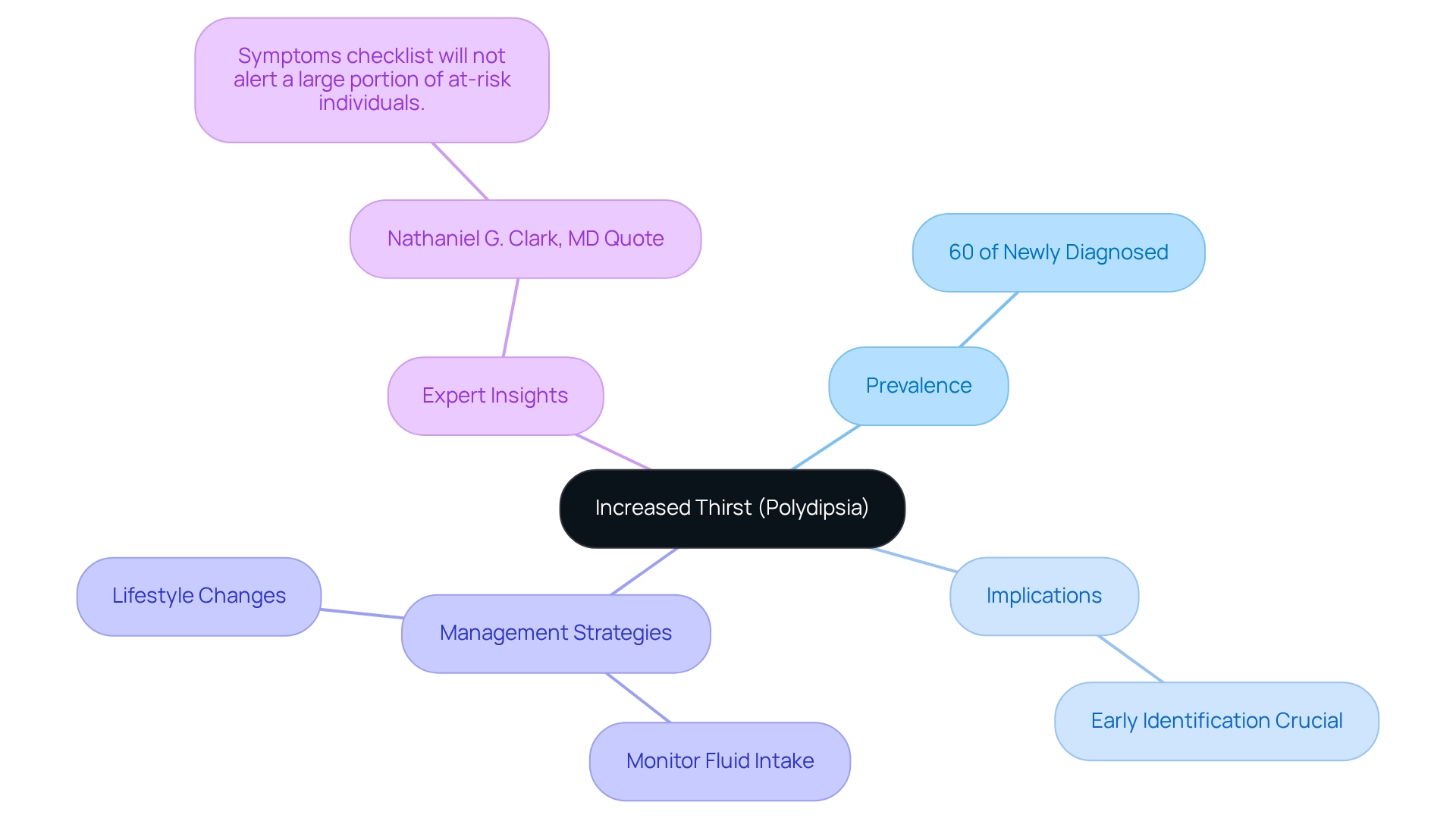
Frequent Urination: Recognizing a Common Symptom of Type 2 Diabetes
Frequent urination, or polyuria, is a common symptom among type 2 diabetes mellitus symptoms that deserves your attention. When blood sugar levels rise, the kidneys work hard to filter and absorb the excess glucose. However, when they can no longer keep up, the surplus glucose is expelled through urine, taking water along with it, which leads to increased urination. This not only means more trips to the bathroom but can also result in dehydration, making you feel thirstier, both of which are type 2 diabetes mellitus symptoms.
Understanding how high blood sugar relates to frequent urination is essential. Studies show that individuals with diabetes face medical expenses that are 2.6 times higher than those without the condition. Recognizing type 2 diabetes mellitus symptoms, such as polyuria, early can lead to timely medical intervention, which may help reduce these costs and prevent complications. The sooner you address this condition, the better your chances of improving your health outcomes, as healthcare professionals emphasize that spotting polyuria can be a crucial step in diagnosing type 2 diabetes mellitus symptoms early.
For example, a case study reveals significant differences in diagnosed conditions related to blood sugar levels among various racial and ethnic groups, with American Indians/Alaskan Natives at 13.6% and non-Hispanic Blacks at 12.1%. This disparity underscores the importance of culturally tailored management strategies for blood sugar issues, as understanding type 2 diabetes mellitus symptoms, such as polyuria, can differ across demographics.
Moreover, high blood sugar can lead to cloudy urine with a sweet or fruity odor, which are important physical signs of the condition. Real-life stories demonstrate how early recognition of polyuria, which is one of the type 2 diabetes mellitus symptoms, has led to timely diagnoses. Patients who noticed increased urination often sought medical advice sooner, resulting in better management outcomes. By being aware of this indicator, you can take proactive steps toward your health, reinforcing that managing type 2 diabetes mellitus symptoms is a shared journey that thrives on collective knowledge and support.
At T2DSolutions, we are here to support newly diagnosed patients in effectively managing type 2 diabetes mellitus symptoms like polyuria. Our community offers testimonials and case studies that highlight the importance of recognizing signs early and the positive impact of prompt intervention. By connecting with T2DSolutions, you can access valuable information and support tailored to your unique needs.

Unexplained Weight Loss: A Warning Sign of Type 2 Diabetes
Unexplained weight loss can be a crucial warning sign indicating type 2 diabetes mellitus symptoms. When the body struggles to utilize glucose effectively due to insulin resistance, it compensates by breaking down fat and muscle for energy, leading to noticeable weight loss. This can be particularly alarming if it occurs without any changes in diet or physical activity. Many individuals diagnosed with type 2 diabetes mellitus symptoms report unexplained weight reduction as one of the early signs, highlighting its commonality among those newly diagnosed.
Recognizing type 2 diabetes mellitus symptoms early is vital, as unmanaged blood sugar levels can lead to serious complications, including heart disease and kidney damage. A case study titled 'The Impact of Blood Sugar Disorders on Overall Health' illustrates how early intervention in patients experiencing unexplained weight loss can lead to improved health outcomes. By seeking medical evaluation, you can better understand the underlying causes of your weight loss and receive the appropriate guidance.
Nutritionists emphasize that metabolic changes related to this condition can significantly influence body weight. As Cherie Berkley notes, "The CDCES is a health professional who can help you achieve your weight goals while maintaining a balanced diet." Therefore, if you are experiencing unexplained weight loss, it is important to prioritize a consultation with a healthcare provider. This can help explore potential diabetes-related issues and initiate timely management strategies.
Additionally, striving for a minimum of 7 hours of rest each night may lower the risk of Type 2 diabetes, further emphasizing the importance of lifestyle choices in managing this condition. If you notice unexplained weight loss, please do not hesitate to seek medical advice to ensure your health is properly managed. For more details and assistance on managing blood sugar conditions, consider exploring T2DSolutions, your comprehensive resource for Type 2 and Type 3 glucose regulation education. Remember, you're not alone in this journey; we are here to support you every step of the way.
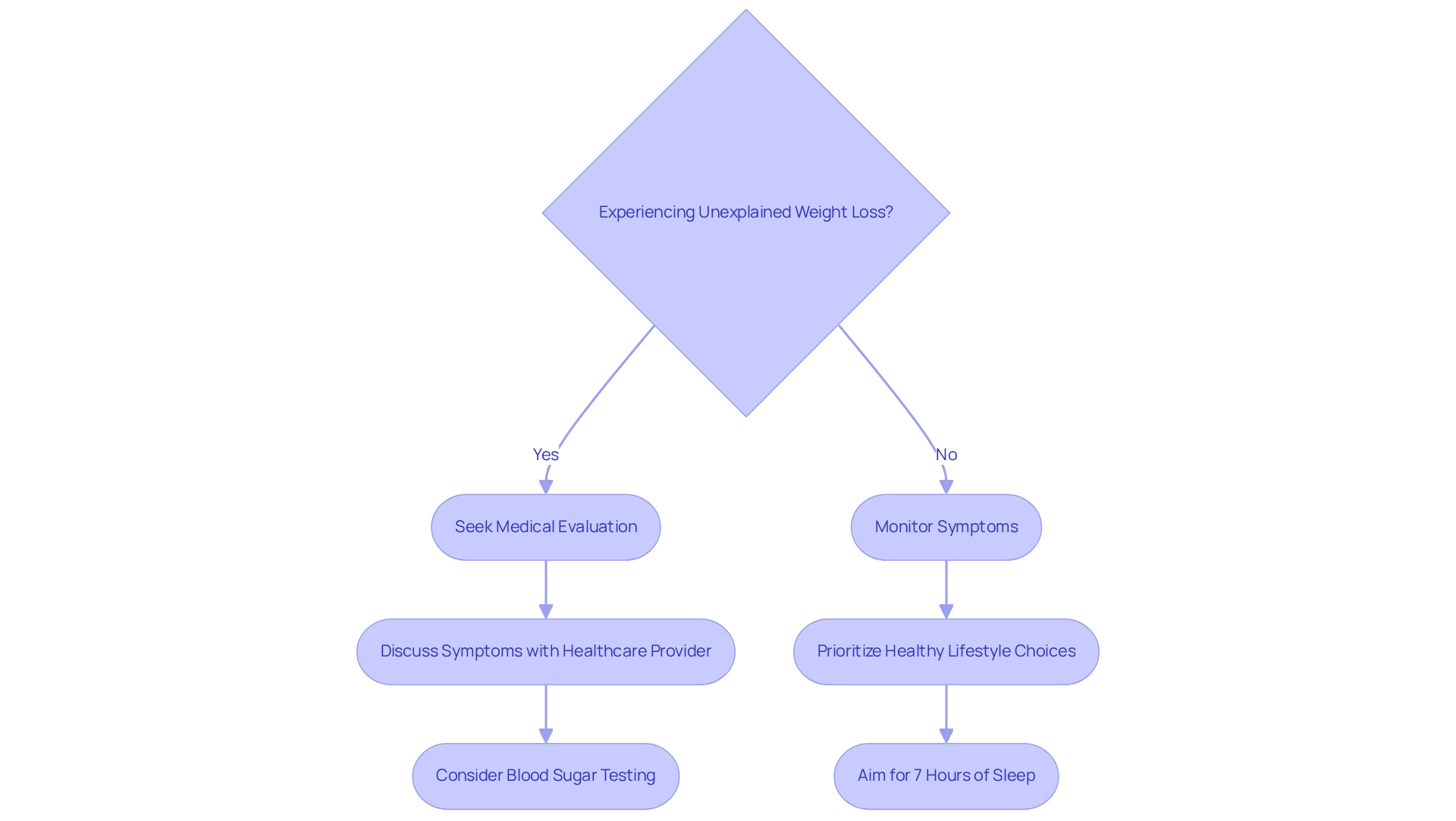
Fatigue: A Common Symptom of Type 2 Diabetes You Shouldn't Ignore
Fatigue: A Common Symptom of Type 2 Diabetes You Shouldn't Ignore
Fatigue is a prevalent symptom of Type 2 Diabetes that is often overlooked. Many people attribute it to lifestyle factors, but persistent tiredness might signal that your body is struggling to effectively utilize glucose for energy. This can lead to exhaustion, even after getting enough rest. Studies show that fatigue is a common experience among newly diagnosed diabetes patients, highlighting the need for awareness and recognition of type 2 diabetes mellitus symptoms.
Research indicates that individuals experiencing type 2 diabetes mellitus symptoms often report ongoing fatigue, which can significantly impact their quality of life. For instance, a recent study identified Diabetes Fatigue Syndrome as a multifactorial condition influenced by lifestyle, nutritional, psychological, and medical factors. This underscores the importance of healthcare providers assessing modifiable factors associated with fatigue and offering support to enhance self-management and overall quality of life (QOL).
Real-life instances illustrate the vital importance of recognizing fatigue as a possible indication of a metabolic disorder. Patients have shared transformative experiences after seeking help for their persistent tiredness, leading to timely diagnoses and effective management strategies. The connection between fatigue and Type 2 conditions is further supported by statistics showing that visceral fat levels can decrease significantly with appropriate lifestyle modifications, potentially alleviating fatigue symptoms. For example, visceral fat levels decreased from 10 kilograms to 9 kilograms, showcasing the positive impact of lifestyle changes on fatigue.
Healthcare professionals emphasize the importance of acknowledging fatigue, which is one of the type 2 diabetes mellitus symptoms, in diabetes patients. As one expert noted, "Nurses should evaluate modifiable factors related to fatigue and provide support to help improve DSM and QOL in this population." This perspective reinforces the necessity for a proactive approach in recognizing and addressing fatigue, ultimately leading to improved health outcomes for those affected by Type 2.
As T2DSolutions launches as a new resource hub for Type 2 conditions education and community support, we invite you to subscribe for updates. Stay informed about managing challenges like fatigue and access valuable resources that can assist you on your diabetes journey. Remember, you're not alone in this journey, and we are here to support you every step of the way.

Blurred Vision: A Serious Symptom of Type 2 Diabetes
Blurred vision can be a concerning sign for those managing type 2 diabetes mellitus symptoms, as it often indicates that blood sugar levels may be out of control. When glucose levels rise, they can cause the lens of the eye to swell, leading to temporary changes in vision. If left unaddressed, this symptom could escalate into serious complications, including diabetic retinopathy, which affects many individuals. It's important to keep a close eye on any vision changes, as they can serve as early warnings of deteriorating glucose management.
Statistics show that blurred vision is one of the type 2 diabetes mellitus symptoms common among people with uncontrolled Type 2 Diabetes, highlighting the need for prompt medical evaluation. Experts stress that effective blood sugar management can slow the onset and progression of diabetic retinopathy, a condition that can result in vision loss if not treated. As ophthalmologists remind us, "Getting dilated eye examinations is crucial. This allows your doctors to identify issues early and offer treatments to prevent vision loss from diabetes." These examinations are essential because they can uncover early signs of diabetic retinopathy and other eye conditions that may not show noticeable symptoms at first.
Real-life stories illustrate the importance of early intervention. Individuals who notice and discuss changes in their vision can receive timely care, potentially preventing serious complications. Understanding the causes and implications of blurred vision is vital for effective management of type 2 diabetes mellitus symptoms. High blood sugar can impact not just vision but also lead to other diabetes-related issues like cataracts and glaucoma, which further contribute to visual disturbances. Therefore, being aware and taking proactive health measures—like scheduling regular eye examinations and discussing any vision changes with healthcare providers—are crucial steps in preserving both vision and overall well-being.
For those newly diagnosed, T2DSolutions offers valuable resources, including informative articles on managing diabetes-related challenges and options for community support. We encourage you to explore these materials to deepen your understanding of blood sugar management and to seek guidance on effectively monitoring your vision. Remember, you're not alone in this journey; we are here to support you every step of the way.
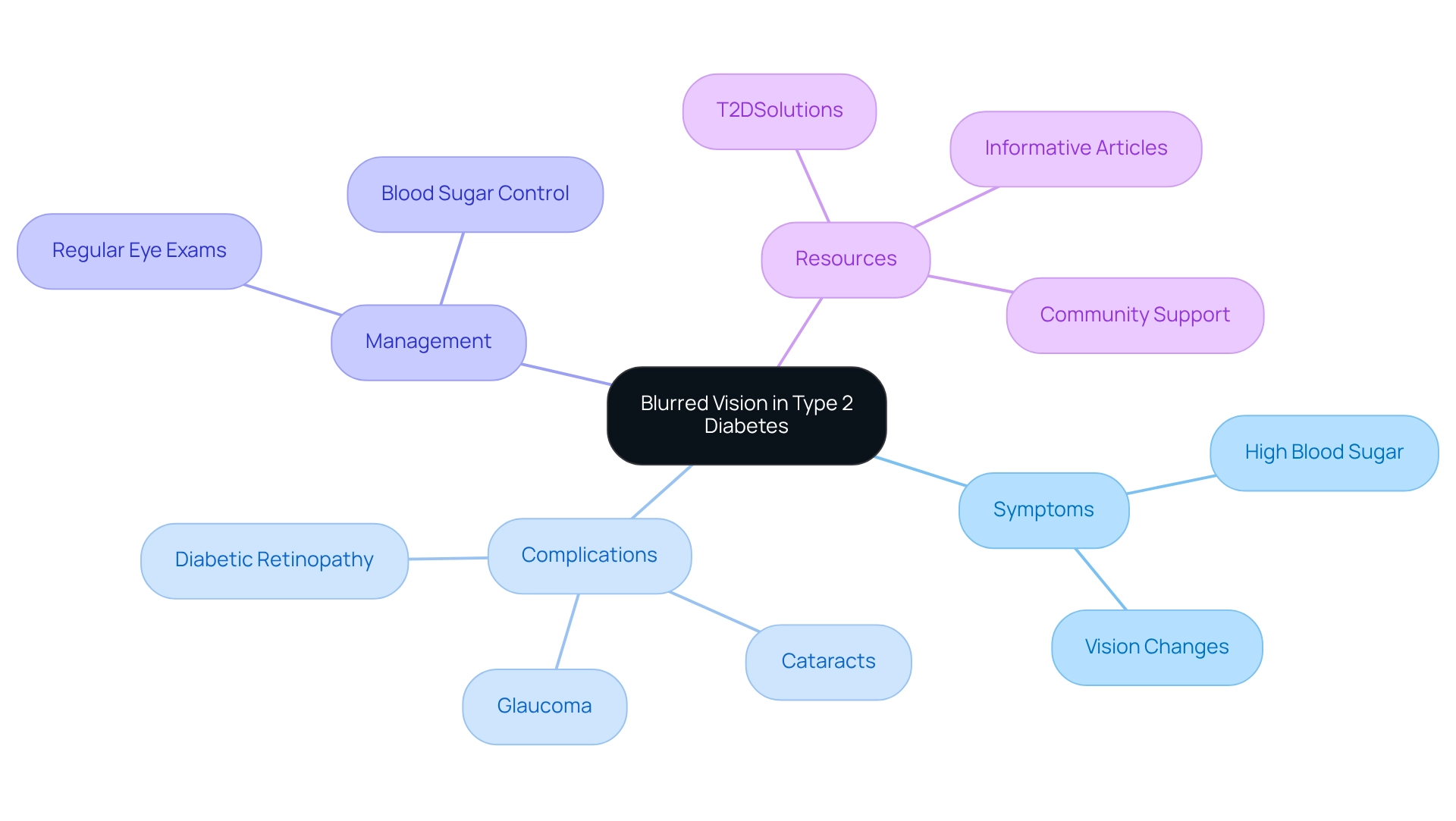
Slow-Healing Sores: A Sign of Complications from Type 2 Diabetes
Slow-healing sores are a critical symptom often linked to type 2 diabetes mellitus symptoms, indicating potential complications that require your attention. It's understandable to feel concerned, as elevated blood sugar levels can significantly impair circulation, hampering the body’s natural healing processes. This dysfunction can lead to infections and more severe health issues if not addressed promptly. Studies show that regulating blood sugar levels and controlling inflammation are crucial for enhancing wound healing in individuals with high blood sugar. Recent research has emphasized innovative local treatment methods, such as advanced dressings and bioengineered skin substitutes, designed to improve cell function in wound healing for those with elevated blood sugar levels. This highlights the significance of prompt intervention.
Statistics indicate that complications from slow-healing wounds are common among individuals with elevated blood sugar levels. A significant percentage faces prolonged recovery from cuts and sores, with the TGCS statistic of 314 from Maruyama K illustrating the burden of wound healing complications in this population. Experts emphasize the need for individuals experiencing type 2 diabetes mellitus symptoms to closely monitor any injuries, as the risk of infection escalates with prolonged healing times. Wound care specialists have indicated that high blood sugar levels can significantly affect the healing process. Therefore, it’s essential for individuals to seek medical attention if they observe any signs of delayed healing. By understanding these risks and the underlying mechanisms, such as the impaired hypoxia-induced VEGF expression in diabetic tissues, as noted by Thangarajah H, you can take proactive steps in managing your health and preventing complications. The results from the case study titled 'Molecular Basis for Impaired Hypoxia-Induced VEGF Expression' further demonstrate how these molecular mechanisms can obstruct effective wound healing, emphasizing the importance of addressing these concerns in managing your condition.
As T2DSolutions launches as a new resource hub for education on this illness, it’s vital for you to utilize available resources to better understand your situation. For additional details on handling blood sugar issues and identifying signs, visit T2DSolutions and subscribe for updates on new material and resources. Remember, you’re not alone in this journey, and we are here to support you every step of the way.
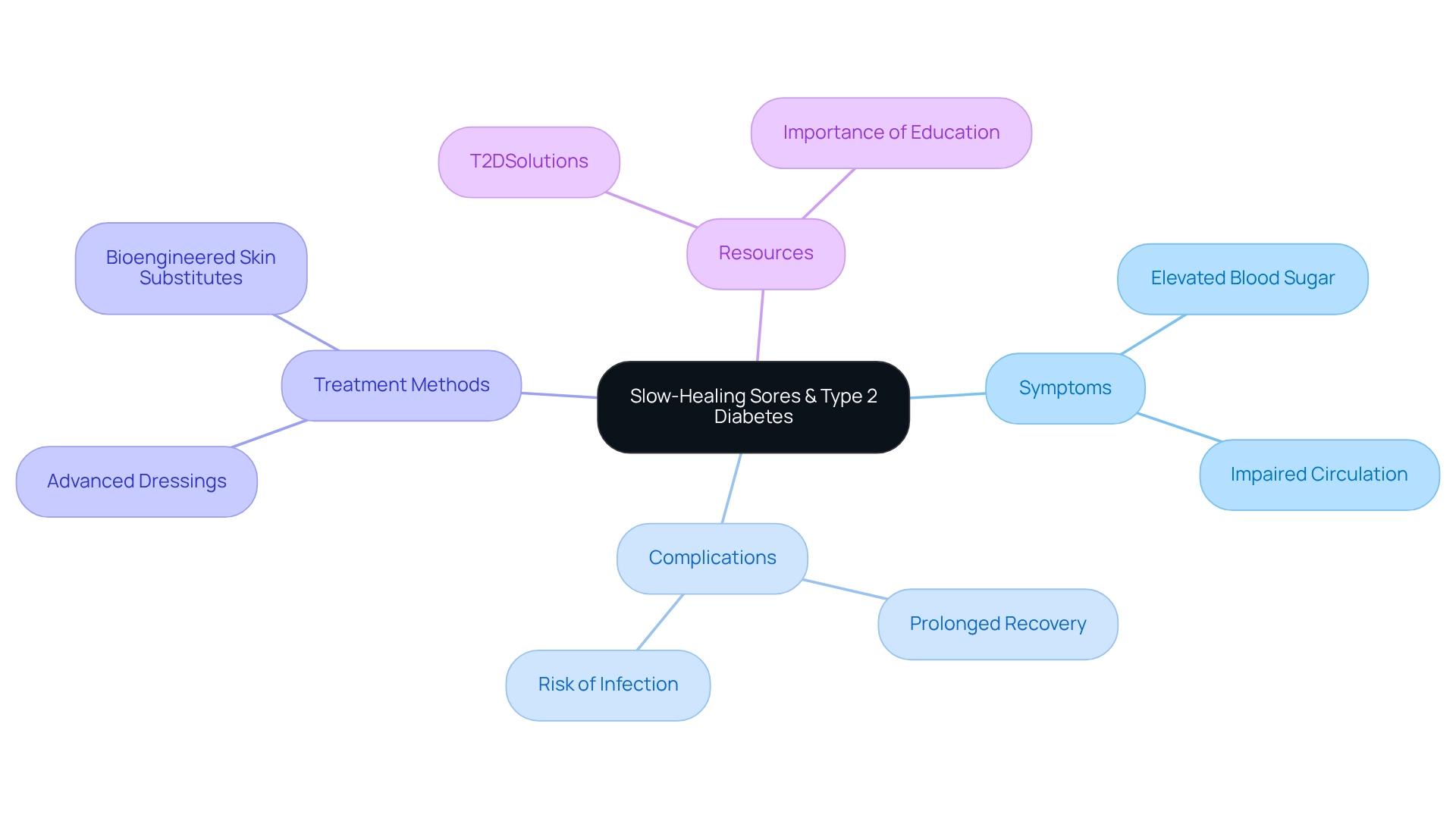
Frequent Infections: A Symptom Linked to Type 2 Diabetes
Frequent infections can be a concerning type 2 diabetes mellitus symptom, largely due to how elevated blood sugar levels affect the immune system. When glucose levels are high, immune function can be compromised, making it harder for the body to fight off infections. As a result, many individuals with high blood sugar often experience recurring urinary tract infections, skin infections, and respiratory infections.
Data reveals a troubling prevalence of urinary tract infections among those with elevated blood sugar. A 2018 study conducted in China, involving over 2,800 participants, found a significant number of women (341 out of 1,072) and men (68 out of 1,783) suffering from these infections. This underscores the importance of recognizing recurrent infections as a critical indicator for managing blood sugar levels.
Research has shown that lifestyle factors play a crucial role in the risk of developing infections for individuals with high blood sugar. A study focused on diet and physical activity revealed that making lifestyle changes could notably decrease the risk of urinary tract infections. This suggests that proactive management strategies, like dietary adjustments and increased physical activity, can help lower infection risks, especially in relation to type 2 diabetes mellitus symptoms. Immunologists, such as S. Bokaee, have pointed out that impaired immune function in affected individuals can lead to a heightened susceptibility to infections. It’s essential for individuals to stay vigilant about their health during this journey.
At T2DSolutions, we understand how important it is to grasp the relationship between Type 2 Diabetes and recurrent infections for effective management. By offering educational resources and support, we strive to empower newly diagnosed patients to take proactive steps, such as embracing a balanced diet, engaging in regular physical activity, and closely monitoring their health. These strategies can enhance health outcomes and help mitigate the risk of complications associated with diabetes. You're not alone in this journey, and we are here to support you every step of the way.
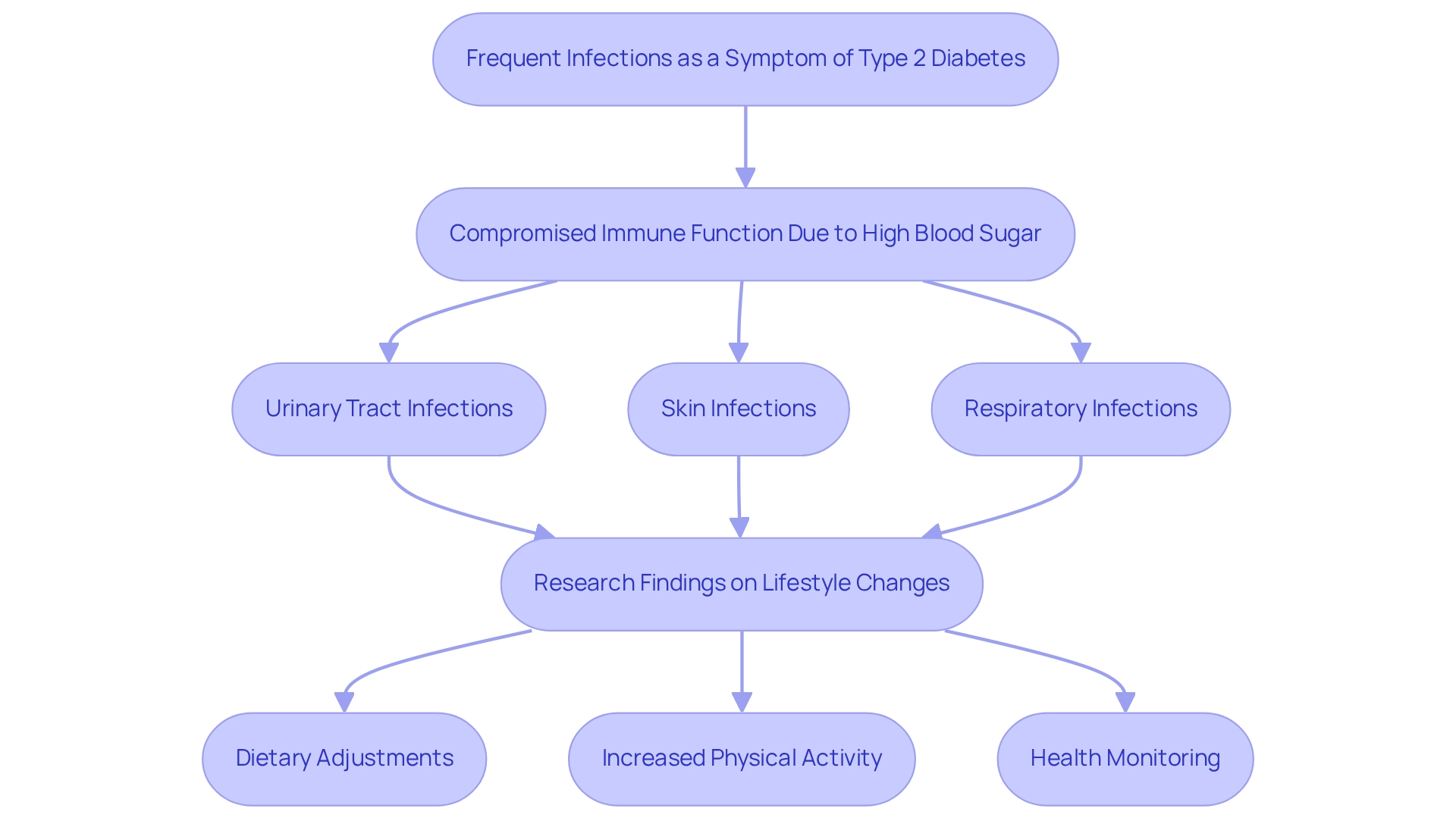
Darkened Skin Patches: A Physical Sign of Type 2 Diabetes
Darkened skin patches, particularly in areas such as the neck, armpits, and groin, can serve as an important physical sign of type 2 diabetes mellitus symptoms, known as acanthosis nigricans. This skin change is often linked to insulin resistance, which can lead to type 2 diabetes mellitus symptoms that typically develop gradually over months or even years. It's crucial to acknowledge these changes in skin appearance, as they can encourage individuals to pursue medical assessment for type 2 diabetes mellitus symptoms, possibly leading to an earlier identification of the condition. According to the Cleveland Clinic, "Acanthosis nigricans can be a sign of prediabetes or diabetes."
Acanthosis nigricans is prevalent among patients with type 2 diabetes mellitus symptoms, serving as a warning signal from the body that deserves medical attention. Dermatologists emphasize that these dark patches may indicate underlying metabolic issues, highlighting the importance of monitoring type 2 diabetes mellitus symptoms and skin changes. Effective management strategies, including lifestyle modifications such as improved diet and exercise, can significantly enhance the appearance of these patches. This improvement can lead to a better quality of life for those affected. Remember, the symptoms of acanthosis nigricans, which can be type 2 diabetes mellitus symptoms, tend to appear slowly, over months or even years, highlighting the need for vigilance in monitoring skin changes.
The NHS advises individuals to remain vigilant about their food choices and to stay hydrated with sugar-free fluids to help manage blood sugar levels. This advice is particularly relevant for managing acanthosis nigricans, as maintaining stable blood sugar levels can positively impact skin appearance. By understanding the significance of acanthosis nigricans and its connection to insulin resistance, individuals can take proactive steps in their management journey. You're not alone in this journey; T2DSolutions is dedicated to offering resources and assistance for those facing these challenges, ensuring that patients have access to the information they need for effective management of their condition.
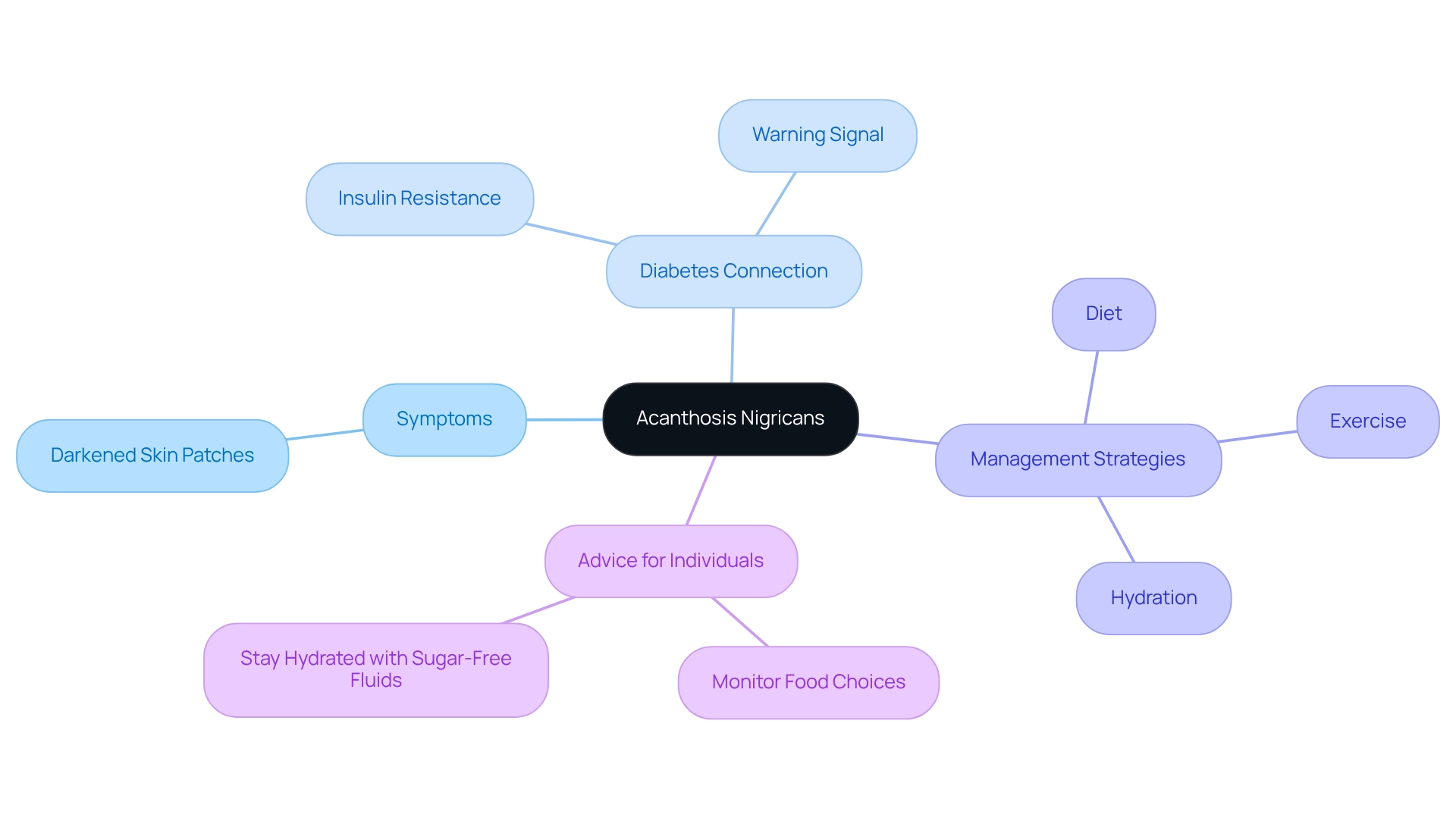
Tingling or Numbness: A Symptom of Nerve Damage in Type 2 Diabetes
Tingling or numbness in your hands or feet can be a sign of diabetic neuropathy, which is among the type 2 diabetes mellitus symptoms. When blood sugar levels rise, they can damage nerves over time, leading to changes in sensation that might go unnoticed at first. It’s important to be aware that around 50% of people with diabetes experience some level of nerve damage. This highlights the need for early detection and understanding of type 2 diabetes mellitus symptoms.
Additionally, unilateral foot drop may occur if a nerve in the leg is damaged, making it difficult to lift your foot, which is one of the type 2 diabetes mellitus symptoms that showcases the impact of nerve injury. Taking early action can significantly reduce nerve damage and enhance your quality of life. Neurologists stress the importance of proactive management; addressing type 2 diabetes mellitus symptoms, such as tingling or numbness, as soon as they arise can lead to better health outcomes.
For instance, a case study revealed that regular medical check-ups allowed for timely adjustments in treatment, effectively lowering the risk of serious complications associated with blood sugar disorders. This proactive involvement in your healthcare is crucial for managing complications like neuropathy.
At T2DSolutions, we are dedicated to supporting those newly diagnosed by providing resources and community support for managing their condition and its complications. Leading a healthy lifestyle, which includes a balanced diet and regular exercise, is essential in managing diabetes. Dr. Sachin Pawar, who leads medical affairs for the India cluster at Procter & Gamble Health, notes that neurotropic B vitamins have shown promise in treating peripheral neuropathy, potentially delaying issues and improving nerve function.
If you’re experiencing tingling or numbness, it’s important to consult a healthcare provider to identify any underlying issues and create a personalized management plan. By prioritizing foot health and being mindful of symptoms, you can take meaningful steps toward preserving your nerve function and overall well-being. For more information and support, visit T2DSolutions to discover how we can assist you on your diabetes management journey.

Conclusion
Understanding the symptoms of Type 2 Diabetes is vital for early detection and effective management. Recognizing key indicators such as:
- Increased thirst
- Frequent urination
- Unexplained weight loss
- Fatigue
- Blurred vision
- Slow-healing sores
- Frequent infections
- Darkened skin patches
- Tingling or numbness
can empower you to seek timely medical advice. This proactive approach can lead to improved health outcomes and a better quality of life.
The prevalence of Type 2 Diabetes continues to rise globally, making awareness and education crucial. By utilizing resources like T2DSolutions, you can access valuable information and support that equip you to navigate your diabetes journey. Early intervention is essential, not only for managing symptoms but also for preventing potential complications associated with the disease.
In conclusion, fostering awareness of these symptoms and taking proactive steps towards health management can significantly alter the course of diabetes. It's important to monitor your health closely and engage with supportive resources, ensuring you are not alone in this journey. By prioritizing education and community support, a stronger, healthier future is within reach for those affected by Type 2 Diabetes. Remember, you are not alone in this journey; we are here to support you every step of the way.
Frequently Asked Questions
What is T2DSolutions and what resources does it offer?
T2DSolutions is a platform dedicated to health awareness, specifically focused on type 2 diabetes mellitus (T2DM). It provides educational resources to help users recognize early symptoms of T2DM, offers dietary plans, exercise routines, and insights into the latest medical research to promote proactive diabetes management.
Why is early recognition of type 2 diabetes mellitus symptoms important?
Early recognition of type 2 diabetes mellitus symptoms is crucial for ensuring timely medical care, which can significantly impact health outcomes. Unmanaged blood sugar levels can lead to severe complications, making awareness essential for effective management.
What are some projected statistics regarding type 2 diabetes mellitus prevalence?
Projections indicate that by 2050, the prevalence of type 2 diabetes mellitus may exceed 10% globally, particularly affecting regions such as Oceania, North Africa, the Middle East, and Central Latin America.
What role does community involvement play in managing diabetes?
Community involvement can enhance patient outcomes in managing diabetes-related issues. Research demonstrates that fostering a supportive community empowers individuals to take control of their health, ultimately improving their quality of life.
What is polydipsia and why is it significant in diabetes management?
Polydipsia, or increased thirst, is often one of the first symptoms of type 2 diabetes mellitus. It occurs when high blood sugar levels lead to dehydration, triggering the body’s thirst response. Recognizing polydipsia early is essential for timely intervention and effective diabetes management.
How common is polydipsia among newly diagnosed individuals?
Approximately 60% of individuals newly diagnosed with type 2 diabetes mellitus report experiencing polydipsia at the onset of their diagnosis.
What is polyuria and how does it relate to type 2 diabetes mellitus?
Polyuria, or frequent urination, is a common symptom of type 2 diabetes mellitus that occurs when the kidneys filter excess glucose from the blood, leading to increased urination and potential dehydration. Recognizing polyuria early can facilitate timely medical intervention.
What are some potential consequences of ignoring symptoms like polydipsia and polyuria?
Ignoring symptoms such as polydipsia and polyuria can lead to further complications and higher medical expenses. Early identification and management of these symptoms can improve health outcomes and reduce the risk of developing more serious conditions.
How can T2DSolutions assist individuals diagnosed with type 2 diabetes?
T2DSolutions provides support through educational resources, case studies, and community engagement to help individuals effectively manage their diabetes symptoms. The platform offers tailored information and encourages users to seek medical advice when necessary.
What should individuals do if they recognize symptoms of type 2 diabetes mellitus?
Individuals who recognize symptoms such as polydipsia and polyuria should seek medical advice promptly. T2DSolutions encourages users to take proactive steps in managing their health and offers resources to support them in this journey.



